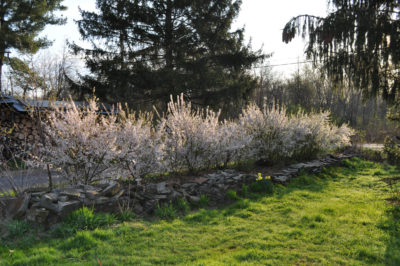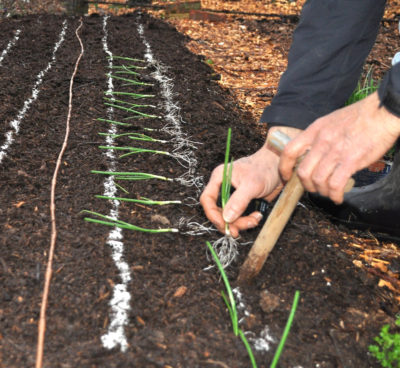Spring?
Spring, You’re Late
Seems like everyone — in the northern half of the country east of the Rockies, at least — is talking about this spring’s weather. Robert Frost (in “Two Tramps in Mud Time”) had it right when he wrote:
The sun was warm but the wind was chill.
You know how it is with an April day
When the sun is out and the wind is still,
You’re one month on in the middle of May.
But if you so much as dare to speak,
A cloud comes over the sunlit arch,
A wind comes off a frozen peak,
And you’re two months back in the middle of March.”
Perhaps T. S. Elliot (in “The Waste Land”) was right in writing that “April is the cruelest month.”
But has this past April really been crueler than most? Usually I pooh-pooh day to day impressions. But even Sammy, who usually bounds over to me from his doghouse each morning when he sees me, stayed in and watched as I crossed the yard a couple of weeks ago over ground recently covered with a dusting of snow. 
Phenology, the study of climate as reflected in the natural cycles of plants and animals, is one way to give the weather an objective assessment. For decades, I’ve recorded the dates on which various plants have blossomed. My interest was horticultural: In spring, plants blossom after experiencing a certain accumulation of warm temperatures. So various blossoms can be indicators of when it’s safe to sow seeds or set out plants of various vegetables and flowers.
Depending on late winter and spring weather, blossoming dates for various plants can vary quite a bit. Microclimate also plays a role, so I’ve tried to always note blossoming on the same plant from year to year. Back in 2010, forsythia bloomed about April 1st, the earliest I’ve ever recorded. Contrast that with 2009, when it bloomed about April 15th, or back in 1984, when it bloomed on April 25th!
This year, forsythia bloomed on April 23rd, late again. Over the years, forsythia bloom dates average around the middle of April, so this year is definitely late. All these forsythia bloom dates are for forsythia on my farmden, which is in a local cold pocket so blossoms spread their yellow petals a few days later than plants even just a few miles away.
Another key indicator for me is cornelian cherry (Cornus mas), whose yellow blossoms are most welcome because they frequently open the first day of spring. Not this year though; mine bloomed on April 20th.
Daffodils typically bloom here in early April, although back in 2016, they bloomed on March 25th. This year, April 21st.
One of my favorite blooming shrubs, also producing very tasty fruit, is Nanking cherry (Prunus tomentosa).

Nanking cherry hedge
Stems on the row of them along my driveway typically form a veritable wave of pinkish white blossoms around the middle of April. As I write, it’s April 24th and that wave is just building. If warm weather continues, it should roll in within a few days. (Update: It did, on the 28th.)
Plants Tell Me When To Plant
It’s tradition to plant corn when “oak leaves are the size of mouse ears.” Considering phenology, I take timing one step further, planting, for example, lettuce seeds

Setting out onion transplants
when forsythias blossom, cabbage transplants when apples blossom, and — this is a tough one — peas a week BEFORE forsythias blossom.
So yes, it has been a “cruel” spring, if you’re wanting some warmth and sun. Then again, this cool weather has retarded, so far at least, blossom development of my fruit trees, which is a good thing. The later these trees blossom, the less chance for the open flowers to be burned by subsequent frosts.
Peas, Where Are You?
The downside to this atypically cool spring weather is that it has delayed planting of annual vegetables and flowers, or their growth if they’s already been planted. I sowed peas, as I always do, on April 1st. Still no sign of the poking up through the ground. I’m going to go outside, scratch around in one of the pea rows, and check if the seeds have either sprouted or rotted.
I’m back. The peas are okay, their first bits of green are peeking up through the surface of the ground.
No matter if the season is unseasonably cool or warm, by this time of year the progression of blossoms provides a feast for the eyes and the nose.



Here in northeast Georgia, I’ve seen daffodils bloom as early as New Year’s Day, and as late as mid-March!
In the same location each year?
I’ve given up direct seeding peas in my low, cold, wet garden. I presprout them in a plastic shoe box with just enough commercial potting mix to hold some moisture. Could the peat moss in the mix inhibit the mold? It surely works better than the moist paper towels I used at first.
I dibble the peas in like you do your onion transplants, for close to 100% success.
The problem is that each pea plant yields relatively few peas, so you have to plant a lot of them. Seeds are sown only a couple of inches apart. All of which means that you have to raise a lot of plants for transplanting if you wand good yields. But you do get an earlier harvest.
Love your articles and garden wisdom..Nate’s Grandma from NH
Thanks Nate’s Grandma.
I sowed 5 varieties of snow and snap peas over a 2 week period, 4/1-4/21. The sprouts emerged over a 1 week period – the last week of April. When I measured the soil temperature on 4/29 it was just 44 °F, not very warm but much warmer than early April.
This is in Poughkeepsie.
I just listened to your podcase about blueberries with Joe Lampl, I really learned a lot. I’ve been planning and want to plant blueberries along my front yard (which is full sun) to created a beautiful sort of natural looking hedge. I also want to enclose some in a protected area in another spot in the yard so that we’ll get to have some berries, also. Where can I get beautiful cedar posts like you have if I don’t own a farm or a land where I can go cut them. I’ve never seen them for sale anywere. What’s the best source for soy bean meal?
My posts are locust, which last much, much longer than cedar. After about 10 years, cedar is typically useless. I have a friend with a forest of locust and my own mini forest, but you might be able to find locust posts on craigslist, newspaper ad, etc. Soybean meal is available at feed stores, such as, around here, Agway. My blueberries have been growing so vigorously that I no longer use soybean meal or other fertilizer. Just annual organic mulch 2-3 inches deep.
Around here, in Southern Ontario, our unusually cold April went from “feeling” to fact when they announced that it had been the coolest April since recordkeeping started back in the early 1900’s! I have, however, found one potential bright spot to the delay in warm temperatures. Since we are so far along in the season, several of our earlier blossoming fruit trees are only now starting to flower and the chances of them being hit by a late frost are minimal at this point – we may actually be in for some nectarines this year 🙂
We have the same situation here in the Hudson Valley of NY. Good for fruit trees but not so good for early vegetables.